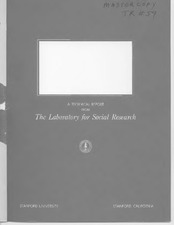| dc.creator | Fennell, Mary L | |
| dc.creator | Tuma, Nancy Brandon | |
| dc.creator | Hannan, Michael T | |
| dc.date.accessioned | 2015-08-15T22:49:29Z | |
| dc.date.available | 2015-08-15T22:49:29Z | |
| dc.date.issued | 2015-08-15 | |
| dc.identifier.uri | https://hdl.handle.net/1969.1/154800 | |
| dc.description.abstract | The authors address four sources of indeterminacy in maximum likelihood estimation (MLE) for multivariate modeling of change using panel data: censoring, caused by changes that occur after the observation period ends; small sample size; interacting censoring with sample size; and collinearity among causal variables. They explore the issues with simulations and conclude that MLE estimates are generally efficient except when censoring is extreme, and efficiency is only slightly affected by collinearity among independent variables. Related publications include Tuma and Hannan (1979) and Tuma, Hannan, and Groeneveld (1979). | en |
| dc.language.iso | en_US | |
| dc.relation.ispartofseries | Technical Report Stanford Sociology;#59 | |
| dc.rights | Attribution 3.0 United States | en |
| dc.rights.uri | http://creativecommons.org/licenses/by/3.0/us/ | |
| dc.subject | statistical censoring | en |
| dc.subject | maximum likelihood estimation | en |
| dc.title | Quality of Maximum Likelihood Estimates of Parameters in a Log-Linear Rate Model | en |
| dc.type | Technical Report | en |
| local.department | Sociology | en |



